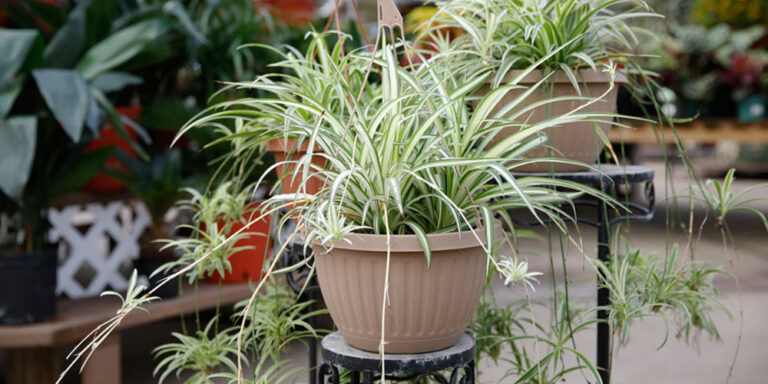Welcome to the world of green wonders, where the Spider Plant (Chlorophytum comosum) gracefully weaves its charm. Hailing from the tropical landscapes of Africa, this resilient beauty dons slender arching leaves adorned with delicate white stripes.
Perfect for both novices and seasoned plant enthusiasts, the Spider Plant – similar to Pothos – thrives on low to moderate care. Its air-purifying prowess and penchant for easy propagation make it a delightful companion for any indoor space. Join us as we unravel the fascinating tale of the Spider Plant – a name that’s as intriguing as its care is undemanding.
Common Spider Plant varieties:
- Variegated Spider Plant
- Zebra Spider Plant
- Hawaiian Spider Plant
- Fire Flash Spider Plant
Care
- Soil: While Spider plants can adapt to various soil types, they prefer loose, well-draining loamy soil. They’re content with a neutral pH but can endure slightly acidic to slightly alkaline soil.
- Water: Maintain a lightly moist, soil for Spider plants. Overwatering leads to root rot which can also kill the plant. To prevent browning of leaf tips due to fluoride and chlorine in water, consider using rainwater or distilled water for container plants.
- Light: Spider plants thrive in light shade outdoors, although they can tolerate heavier shade. Direct sunlight should be avoided as it can scorch their leaves. Indoors, placing them near a bright window is the best choice.
- Temperature: Spider plants thrive in warm, humid environments and should be shielded from temperatures below 50 degrees Fahrenheit. Protect them from drafts and air conditioning indoors.
Propagation
Spider plants are like friendly neighbors who are always up for sharing. Don’t worry, because propagating them is very simple:
- Once those mini-plantlets hanging from the spider plant’s stem have roots about an inch or two long, it’s showtime. Snip them off gently with sharp pruners, keeping those roots snug.
- Pop them into a clay or plastic pot filled with well-draining soil, and keep things moist (but not soaking) until they settle in.
- If the plantlet’s roots are still a work in progress, no problem. Place a small pot with soil near the parent plant, put the plantlet on top, and keep the soil cozy. Roots will sprout in a few weeks. Snip, separate, and let the plant party continue.
Pruning
Spider plants are low-maintenance plants that rarely require pruning. To prevent toxic seed formation, snip faded flowers. Trim offshoots, or “spiderettes,” for propagation. Easy-peasy care for these green companions!
Common Pests
Frequently Asked Questions
They crave bright, indirect light, not harsh sun. Plant in well-draining soil, water lightly, and keep humidity happy. Lower light equals slower growth and maybe no babies. Remember, too little light might fade those cool stripes.
How often should I water spider plant?
They’re content with regular watering, about once a week. Let the soil chill a bit between drinks – easy does it!
Where is the best place to keep a spider plant?
Bright but no blazing sun, cold’s fine but above 8 degrees in winter. Indoors, placing them near a bright window is the best choice.
How do you take care of a spider plant indoors?
Give it comfy light, not too bright or dim. Keep things cozy temperature-wise. Moist soil is the key – water weekly in warmer months and let it dry more in winter. Happy plant, happy life!
Do you water spider plants from the top or bottom?
Spider plants, philodendron, peace lilies, and crassulas share the same quirk: they’re bottom-water fans. And for delicate seedlings, it’s all about the tray life – they soak up water to stay safe from above-water harm.


